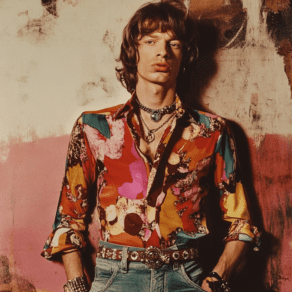What are 501s?
The Levi’s 501 jeans have a fascinating history. First introduced in 1873, the number “501” refers to the lot number used by Levi Strauss & Co. to identify the classic copper-riveted waist overalls, as jeans were originally called. It became an iconic style due to its rugged construction, button-fly closure, and durable denim, which appealed to workers, cowboys, and later, rebels and youth. By the 1950s and beyond, the 501 became synonymous with American culture, individuality, and youth rebellion, worn by figures like James Dean and Marlon Brando.
Levi’s Evolution and Global Success in the 1950s, 60s, and 70s
Levi’s success in the 1950s, 60s, and 70s can be attributed to its ability to resonate with evolving youth culture and societal shifts. In the 1950s, Levi’s jeans were popularized in the U.S. by rebels like James Dean in Rebel Without a Cause (1955) and Marlon Brando, appealing to a young audience seeking rebellion and individuality.
The counterculture movement in the 1960s embraced Levi’s as a symbol of freedom. Hippies and activists alike wore Levi’s, and stars like Steve McQueen in his casual off-screen appearances popularized them.


Marilyn Monroe’s iconic role in The Misfits (1961) helped elevate Levi’s to new heights in pop culture. Her effortless, casual look in Levi’s jeans cemented the brand’s connection to rebellious style and feminine allure, proving that denim wasn’t just for the working class or rebels—it could also be sensual and sophisticated. Monroe’s influence, along with her glamorous yet approachable persona, made Levi’s a versatile symbol of style, appealing to women and further expanding the brand’s global success in the early 1960s.
Levi’s also expanded into bell-bottoms and new washes to match the era’s experimental fashion.
During the 1970s Levi’s solidified its place in both workwear and fashion culture. The decade saw the rise of the Orange Tab line, which offered more affordable, trendy fits aimed at a younger crowd. Denim jackets, jeans with flared cuts, and patchwork designs became staples.
By the 1970s, Levi’s expanded globally, gaining popularity in Europe, Japan, and beyond. The brand catered to youthful, rebellious, and free-spirited consumers, symbolizing freedom and self-expression.
Levi’s jeans were often associated with independence, nonconformity, and casual style, attracting segments like teenagers, artists, and working-class consumers. The brand’s simple yet iconic design, durable quality, and cultural appeal ensured its success across multiple countries, particularly in the U.S., UK, and Japan.
Vintage Fashion Evolution
Levi’s vintage style shifted from durable workwear in the early 20th century to youth rebellion in the 1950s, then to the experimental and countercultural vibes of the 60s and 70s. Vintage fashion collectors today revere these decades for their timeless fits and iconic status in pop culture.
The brand’s history reflects not only its contribution to fashion but also its connection to cultural movements over the years.
How can you tell if Levis 501 are vintage?
To determine if a pair of Levi’s 501 jeans is vintage, look for several key features:
- Selvedge Denim: Older 501s often use selvedge denim, visible as a finished edge inside the outseam.
- Big “E” Tab: Vintage Levi’s from pre-1971 have a red Levi’s tab with a capital “E” (“LEVI’S”).
- Single Stitching: Older jeans have single stitching along the back pockets.
- Back Patch: The leather patch on vintage pairs can show signs of age or distinct vintage logos.
- Button Fly: Look for a sturdy button fly, a signature feature of 501s.
These details help determine authenticity and age.
Value of Vintage Levi’s 501 Jeans from the 1950s, 1960s, and 1970s
Vintage Levi’s 501 jeans from the 1950s, 1960s, or 1970s can vary significantly in value depending on their condition, rarity, and specific details like the red tab or button type. On average, prices for vintage 501s from these decades can range from $200 to over $1,000, with particularly rare or well-preserved pairs reaching much higher values at auctions or vintage markets. Collectors and denim enthusiasts often seek these jeans for their historical and cultural significance.
Exploring Levi’s Archives: A Journey Through Denim History
Levi’s Archives, located at Levi Strauss & Co.’s headquarters in San Francisco, holds a collection of historic denim garments and memorabilia dating back to the company’s founding in 1853. Additionally, the Levi’s Plaza headquarters often displays iconic vintage pieces, including items from the 1950s through the 1970s, showcasing how the brand evolved. You can also visit exhibitions at various fashion museums, like the Fashion Institute of Design & Merchandising Museum (FIDM), which occasionally feature Levi’s in vintage collections.






Leave a Comment